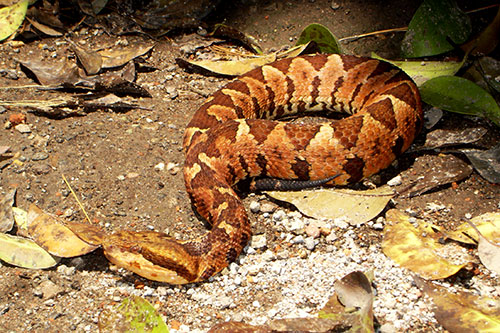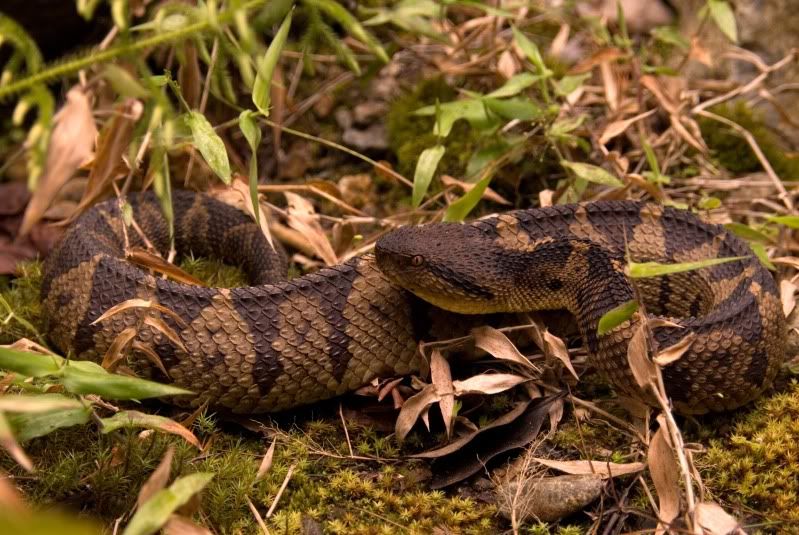Atropoides
Atropoides nummifer
The Bouncing Terciopelos ( Atropoides ) are a snake genus of the subfamily of pit vipers. The genus comes with six species found in Central America. All species are poisonous, but toxic in humans is low and limited to short -lasting pain and slight swelling. The German name refers to the supposed ability of the animals to be able to bridge the Crashing distances from the own body length or more. However, this is greatly exaggerated, actually put the animals during Crashing at best little more than half the body length back.
- 6.1 Notes and references
- 6.2 Literature
Features
Physique
Jumping Terciopelos are small to medium sized, but very powerful and strong stocky snakes. The head is large, broad and clearly deducted from the neck, the snout is broadly rounded, and the eyes are relatively small. The tail is not suitable for gripping and relatively short, it accounts for less than 15% of the total length. The smallest species usually reaches total lengths of 35-60 cm, the largest of 75-95 cm, max. 120 cm.
Squamation
The rostral is wider than tall and a concave shape at the bottom. There are three Praeocularia, of which the upper one is significantly larger than the other. The species usually show only a narrow, elongated Supraoculare, but in some species it is divided in some individuals in several small, keeled scales. The top of the head is covered with small keeled scales. The number of supralabials is 8 to 12, the number of Infralabialia 9 to 14 The number of ventral scales ( Ventralschilde ) varies 103-155, the number of Subcaudalia 22-40 and the number of dorsal scale rows in the middle of the body between 21 and 29
Coloring
The basic color of the top is usually gray - brown or red- brown, but can also be yellow, cream, purple or brownish black to be. Show on the back of the animals on this reason, a number of large, more or less angular, dark spots, which are often associated with each other and thus form a zigzag ribbon. Are including one or more rows of smaller spots on the flanks. All species have a narrower or wider dark Postokularstreifen, which extends from the posterior edge past the muzzle angle.
Distribution and habitat
Jumping Terciopelos are restricted to Central America, the range extends from northeastern Mexico into middle Panama. The areas of the individual species are each comparatively small. Most species are restricted to humid, tropical forests from the rainforest to cloud forest, at least one species ( A. occiduus ) inhabited at certain seasons but also dry pine forests. Most species are prevalent at altitudes above 1000 m.
System
The number of species and subspecies has been controversial for a long time, Campbell & Lamar recognize five species are recognized more for each no subspecies. In 2008, was described as another type Atropoides Indomitus.
- Atropoides mexicanus ( Duméril, Bibron & Duméril 1854)
- Atropoides nummifer ( Rüppell, 1845)
- Atropoides occiduus ( Hoge 1966)
- Atropoides olmec Pérez- Higareda, Smith and Juliá - Zertuche 1985
- Atropoides Indomitus Smith & Ferrari - Castro 2008
After molecular genetic studies without consideration of A. Indomitus the monophyly of the genus Atropoides in this composition with respect to A. picadoi is doubtful, but the results so far are inconclusive.
Lifestyle, diet, and reproduction
Almost all species of the genus are predominantly diurnal, rare nocturnal and almost entirely ground alive. The juveniles eat invertebrates and small lizards, the adult animals mainly small mammals. All species are viviparous, young are usually born in the rainy season. The reproduction is dependent on size, 8-45 pups per litter are proven.
Poison
Unlike many other pit vipers, the species of the genus Atropoides after the bite can not immediately release, but keep the bite upright and make it chewing movements. All species are poisonous, but toxic in humans is low and limited to short -lasting pain and slight swelling.








.jpg)

